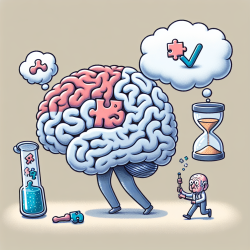Unlocking the Secrets of Brain Health: Insights from White Matter Hyperintensities
As a practitioner in the field of special education, staying informed about the latest research in cognitive and neuropsychiatric health is crucial. One such research study, "Subclinical Cognitive and Neuropsychiatric Correlates and Hippocampal Volume Features of Brain White Matter Hyperintensity in Healthy People," offers valuable insights that can enhance our understanding of brain health and aging.
What Are White Matter Hyperintensities?
White matter hyperintensities (WMH) are areas in the brain that appear brighter on certain MRI scans. They are often seen in older adults and are linked to various cognitive and neuropsychiatric changes. The study in question explored the relationship between WMH, cognitive function, and neuropsychiatric symptoms in healthy individuals aged 50 to 80.
Key Findings
- WMH are associated with subtle cognitive impairments, particularly in executive functions and long-term visuospatial memory.
- Subclinical neuropsychiatric symptoms such as apathy and anxiety are significantly linked to the presence of WMH.
- WMH are also associated with reduced hippocampal volume, which is a risk factor for cognitive decline and dementia.
Implications for Practitioners
Understanding the implications of WMH can be instrumental in early detection and intervention strategies. Here are some ways practitioners can apply these findings:
- Early Screening: Implementing routine cognitive and neuropsychiatric assessments for individuals over 50 could help identify those at risk of developing significant cognitive impairments.
- Targeted Interventions: Developing interventions focused on reducing anxiety and apathy could potentially slow down the progression of cognitive decline associated with WMH.
- Collaborative Care: Working closely with neurologists and psychiatrists can provide a more comprehensive approach to managing the effects of WMH.
Encouraging Further Research
While this study provides valuable insights, it also highlights the need for further research. Longitudinal studies could offer more information on the progression of WMH and its impact on cognitive and neuropsychiatric health. Additionally, exploring the effects of lifestyle changes and therapeutic interventions on WMH could open new avenues for prevention and treatment.
Conclusion
The presence of white matter hyperintensities in the brain is more than just an age-related change; it is a potential indicator of future cognitive and neuropsychiatric challenges. By integrating the findings from this study into practice, practitioners can play a crucial role in the early identification and management of these risks, ultimately contributing to better outcomes for aging populations.
To read the original research paper, please follow this link: Subclinical Cognitive and Neuropsychiatric Correlates and Hippocampal Volume Features of Brain White Matter Hyperintensity in Healthy People.










